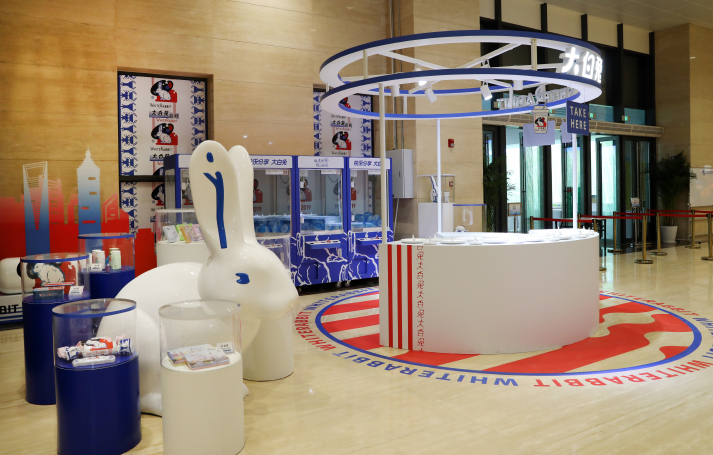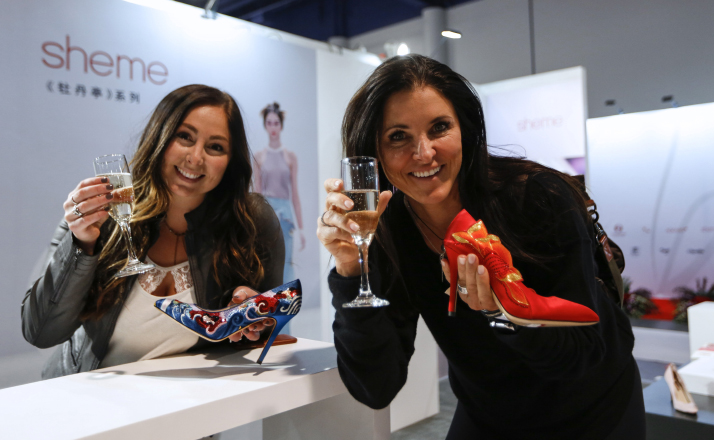A Hanfu dance in session at a park in Fuzhou, Fujian Province in southeast China, on December 22, 2019 (XINHUA) Shan Zhen, a fashion blogger in her 20s with about 1 million followers on the Chinese social media platform Weibo, recently posted, "Li-Ning sneakers are comfortable and have a great design. I love China Chic!" In the comments section, many users echoed her view and posted their own pictures of the sneakers. After years of sluggish growth due to rising competition and old-fashioned products, Li-Ning, a sportswear brand founded by former Olympic gymnastics champion Li Ning in 1990, has revived its past glory which began as a sponsor of the 1990 Beijing Asian Games, and again become a well-received fashion brand among young consumers, riding on the trend of China Chic. Since 2018, China Chic, or guochao, has become all the rage, transforming into a new sales magnet. Once referred to as Chinese streetwear, it has developed into a concept involving emerging domestic brands and designs inspired by Chinese culture. While international fashion brands keep entering the Chinese market, an increasing number of domestic consumers, especially the young, have developed a great interest in China Chic products, which make them feel connected to the Chinese culture. According to data from Xiaohongshu, the Chinese equivalent of Instagram for lifestyle sharing, posts related to these products grew by 116 percent year on year in the first half of 2019, with over 5 million users sharing their views. A report released in April 2019 by Suning, a Chinese retailer, showed that people born in the 1990s accounted for 35.64 percent of the domestic consumers of China Chic products. Cosmetics, clothes and shoes are the top three China Chic product categories, according to Fanli.com, a Chinese online discount shopping site. "Since Chinese consumers' demands have been upgrading, the emergence of China Chic brands is in line with their expectations of showcasing personality, and suggests their rising confidence in domestic products," Cui Lili, Executive Director of the Institute of E-Commerce at the Shanghai University of Finance and Economics, told Beijing Review.  Chinese candy brand White Rabbit's booth at the press center of the Second China International Import Expo on October 31, 2019 (XINHUA) Robust rise Along with the revival of China Chic, many Chinese companies have made room for growth by rebranding and mixing tradition and innovation in their products, with booming e-commerce platforms contributing to sales growth. Li-Ning suffered losses of about 3 billion yuan ($433 million) from 2012 to 2014, closing over 1,800 stores in 2013. Introducing new designs with Chinese elements, it made its New York Fashion Week debut in February 2018, attracting as much attention as more formal wear. As models unveiled the new designs, which included hoodies with the Chinese characters for "China Li-Ning," and sneakers inspired by the traditional Chinese philosophy Taoism, more domestic consumers flocked to the brand. According to its 2018 annual report, Li-Ning's revenue exceeded 10 billion yuan ($1.4 billion) for the first time since 1990. In the first half of 2019, its revenue totaled about 6 billion yuan ($867 million), a year-on-year increase of 32.7 percent. Down jacket brand Bosideng is also making a splash. It impressed audiences with its new collection featuring patterns with traditional Chinese painting at the Fall/Winter New York Fashion Week in 2018. On November 11, 2019, during the annual online shopping festival, sales of its down jackets reached 650 million yuan ($94 million), up 58 percent year on year. Vintage is another selling point for China Chic products among nostalgic consumers. The time-honored shoe brands Feiyue and Warrior have become a new craze for fashion-conscious Chinese people in recent years. Feiyue, established in Shanghai in 1959, became a popular brand among schoolchildren of the older generations. It has gained new life since 2010 with innovative designs that cater to the new generations. Besides sporty designs, Feiyue's classic white canvas shoes are embraced by the young also for their low prices. On Tmall, e-commerce giant Alibaba's online marketplace, the price of the sneakers is about 50 yuan ($7.2). According to Cui, the prices of its collaboration products can be higher. With more diverse products, Feiyue now gets as much attention as international brands like Adidas and Nike. Along with domestic consumers, it has attracted many foreign fashion bloggers and stars, such as Orlando Bloom, who bought Feiyues for his son and himself. Warrior, or Huili in Chinese, was another top choice among young people in the last century. Like Feiyue, it has enhanced its sales through online channels in recent years. According to the brand, the sales volume of its Tmall store exceeded 200 million yuan ($29 million) in 2018. To woo young consumers, many Chinese brands have developed various derivative products with distinctive designs by collaborating with other brands. In September 2018, the hot sauce maker Laoganma, together with the U.S. clothing brand Opening Ceremony, introduced hoodies with its logo, driving sales of its store on Tmall by 240 percent. The candy brand White Rabbit has made bolder moves by introducing new products such as lip balm, perfume and sweaters in cooperation with cosmetics and clothing brands since 2018, which have attracted many young consumers to the delicate designs. "The new White Rabbit products are popular because they remind domestic buyers of their childhood," Dong Yang, one of the designers of the clothes, told Chinanews.com.  Models wear Li-Ning's new collection at New York Fashion Week on February 12, 2019 (XINHUA) Tracing traditions As Chinese elements become highlights of the fashion and cosmetic industry, the demand for other creative products has also grown. The Palace Museum, the imperial palace in the Ming (1368-1644) and Qing (1644-1911) dynasties and one of the major tourist destinations in Beijing, has rolled out products related to its collections since 2018. Its online stores, which sell derivative products, have over 10 million followers. In December 2018, online buyers snapped up more than 100,000 Palace Museum-themed lipsticks in four days during a promotional event on Tmall. As hanfu, the traditional attire of the Han ethnic group, has become increasingly popular among young people in recent years, a promising market has developed. According to data from state broadcaster China Central Television, the hanfu market had more than 2 million consumers in September 2019, with a total value of 1.09 billion yuan ($158 million). In the same period, sales of hanfu garments increased by 146 percent year on year. Developing an interest in hanfu about 14 years ago, Li Xiaoxuan, a staff member at the Beijing Hanfu Association, is glad to see a booming market of the genre, where she can buy a variety of traditional-style apparel, since she had to get her clothes tailor-made. "About three fifths of my clothes are hanfu. Now I spend over 2,000 yuan ($289) on new purchases every year," she told Beijing Review, adding that she dresses in hanfu on many occasions, including shopping and traveling. According to Li, the development of the hanfu market has driven up many related industries such as ancient-style shoe and ornament production, and boosted sales of traditional handicrafts.  Visitors take part in a Chinese footwear brand promotion event during the International Footwear Exhibition in Las Vegas, the U.S., on August 12, 2019 (XINHUA) Controlling the chaos As more brands flood into the China Chic market, industry observers have warned that those trying to make quick money by riding the wave will face difficulties. According to some Weibo users, many China Chic cosmetics designs are attractive, but the quality is quite low. In January 2019, quality complaints led the Palace Museum to halt cosmetic production before new products were released in October. "Businesses need to introduce China Chic products that can better meet consumers' demands instead of just focusing on eye-catching designs," Cui said. The lack of innovative and independent designs also remains a problem. Some brands load their products with Chinese elements in an awkward design, without considering consumers' preferences, or even copy others' designs. Producers need to fully understand Chinese traditional culture, while standards should be developed to regulate the industry, Dong Yan, a professor at the Beijing Institute of Fashion Technology, told Xinhua News Agency. While non-standard designs are still causing chaos in the hanfu market, Zhang Jing, Vice Chair of the Beijing Hanfu Association, believes that it is getting better as demands improve. "Low-quality products will be gradually squeezed out of the market," she told Beijing Review. For sustainable growth, brands need to develop independent and well-received designs, enhance quality control and gain more influence both at home and abroad, Pan Helin, a senior researcher at the public policy think tank Pangoal Institution, said in an interview with Beijing Review. Copyedited by Rebeca Toledo |
Archiver|手机版|小黑屋|汉服维基(Hanfu wiki)
GMT+8, 2024-11-22 14:12 , Processed in 0.029089 second(s), 15 queries .
Powered by Discuz! X3.4
Copyright © 2001-2020, Tencent Cloud.